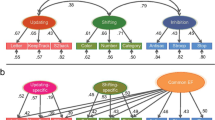Abstract
An analysis of the language backgrounds of 237 persons in a psychology department subject pool is presented. Specific findings indicate that (a) only about two-thirds of the subjects were native speakers of English, (b) native English speakers can be divided into several different groups on the basis of bilingual background and age of acquisition of their second language, (c) the number of native English speakers who would be considered “ideal” for psycholinguistic experiments in English (e.g., monolinguals and bilinguals who acquired a second language in or after adolescence) is only about a third of the sample, (d) nonnative English speakers appear to have their native, non-English-language abilities reduced as a function of their acquisition of English; that is, English appears to displace other languages that a person knows (the English displacement effect), and (e) age of English acquisition is shown to be an important factor, by correlating negatively with rated English abilities and reported Scholastic Aptitude Test (SAT) scores, and positively with rated ability in a non-English language.
Similar content being viewed by others
References
Aaronson, D., & Ferres, S. (1987). The impact of language differences on language processing: An example from Chinese-English bilingualism. In: P. Homel, M. Palij, & D. Aaronson (Eds.),Childhood bilingualism: Aspects of linguistic, cognitive, and social development (pp. 75–126). Hillsdale, NJ: Erlbaum.
Alderman, D.L. (1982). Language proficiency as a moderator variable in testing academic aptitude.Journal of Educational Psychology, 74, 580–587.
Bahrick, H.P. (1984). Semantic memory content in permastore: Fifty years of memory for Spanish learned in school.Journal of Experimental Psychology: General, 113, 1–29.
Bahrick, H.P., & Phelps, E. (1987) Retention of Spanish vocabulary over 8 years.Journal of Experimental Psychology: Learning, Memory, and Cognition, 13, 344–349.
Bates, E., & MacWhinney, B. (1981). Second-language acquisition from a functionalist perspective: Pragmatic, semantic, and perceptual strategies. In H. Winitz (Ed.),Native language and foreign language acquisition Annals of the New York Academy of Sciences (Vol. 379), pp. 190–214).
Ben-Zeev, S. (1977). The influence of bilingualism on, cognitive strategy and cognitive development.Child Development, 48, 1009–10018.
Cummins, J. (1987). Bilingualism, language proficiency, and metalinguistic development. In P. Homel, M. Palij, & D. Aaronson (Eds.),Childhood bilingualism: Aspects of linguistic, cognitive, and social development. Hillsdale, NJ: Erlbaum.
Grosjean, F. (1982).Life with two languages. (pp. 284–288) Cambridge, MA: Harvard University Press.
Hirst, W., & Kalmar, D. (1987). Characterizing attentional resourcesJournal of Experimental Psychology: General, 116, 68–81.
Homel, P., & Palij, M. (1987). Bilingualism and language policy: Four case studies. In P. Homel, M. palij, & D. Aaronson (Eds.),Childhood bilingualism: Aspects of linguistic, cognitive, and social development. Hillsdale, NJ: Erlbaum.
Ianco-Worrall, A.D. (1972). Bilingualism and cognitive development.Child Development, 43, 1390–1400.
Lambert, W.E. (1977). The effects of bilingualism on the individual: Cognitive and sociocultural consequences. In P.A. Hornby (Ed.),Bilingualism: Psychological, social, and educational implications (pp. 15–27) New York: Academic Press.
Lambert, W.E., & Tucker, G.R. (1972).Bilingual education of children: The St. Lambert experiment. Rowley, MA: Newbury House.
Lenneberg, E.H. (1967).Biological foundations of language New York: Wiley.
Palij, M. (1980).Semantic facilitation on a bilingual lexical decision task. (ERIC Document Reproduction Service No. ED 192 611) Stony Brook, NY: State University of New York.
Palij, M. (1987). Assessing language background differences (Report WPP 87-1).Working Papers in Psycholinguistics (ERIC Document Reproduction Service No. ED 299 814). New York: Department of Psychology, New York University.
Palij, M., & Aaronson D. (1990).A questionnaire for assessing language background differences. Manuscript in preparation.
Palij, M., & Homel, P. (1987). The relationship of bilingualism to cognitive development: Historical, methodological, and theoretical considerations. In P. Homel, M. Palij, & D. Aaronson (Eds.),Childhood bilingualism: Aspects of linguistic, cognitive, and social development. Hillsdale, NJ: Erlbaum.
Spelke, E., Hirst, W., & Neisser, U. (1976). Skills of divided attention.Cognition, 4, 215–230.
Zikopoulos, M. (1987).Open doors: 1986/87. New York: Institute of International Education.
Author information
Authors and Affiliations
Rights and permissions
About this article
Cite this article
Palij, M. Acquiring English at different ages: The English displacement effect and other findings. J Psycholinguist Res 19, 57–70 (1990). https://doi.org/10.1007/BF01068185
Accepted:
Issue Date:
DOI: https://doi.org/10.1007/BF01068185




